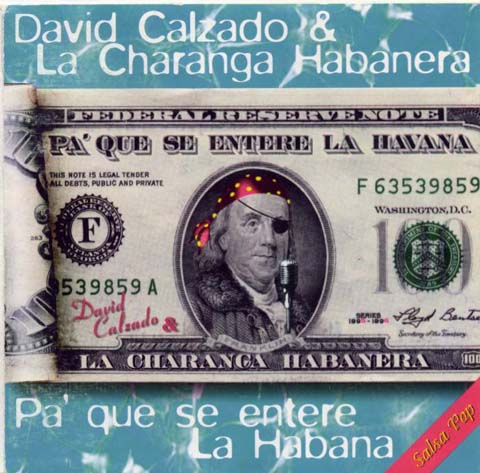Indice - Table of contents
Lo Nuevo[hide]
Reportes: From The St... : Cubadisco 2...
Fotos: Tom Ehrlich
Staff: Kristina Lim
Musicos: Juan Formell
Musicos: Yordamis Megret Planes
Musicos: Yasser Morejón Pino
Musicos: José Luis "Changuito" Quintana...
Musicos: Dennis Nicles Cobas
Fotos: Eli Silva
Grupos: Ritmo Oriental : 1988 - Vol. IX - 30 a...
Musicos: Rafael Paseiro Monzón
Musicos: Jiovanni Cofiño Sánchez
Fotos: Tom Ehrlich : 2024 Monterey Jazz, P...
Resenas: Vacilón Santiaguero (Circle 9 ...
Fotos Del Día [hide]
SpanishEnglishDiscography - Pa' que se entere La Habana

1995 - Pa' que se entere La Habana
por Kevin Moore ©2001
traducido al español por Ilán Greenfield
Llega 1995 y La Charanga Habanera y su segundo LP, «Hey You Loca», son la sensación de La Habana. Los conciertos se repletan de jóvenes charangueros que bailan y se visten como sus ídolos y se conocen las canciones de memoria a medida que, una tras otra, se van conviertiendo en éxitos superestelares. Y justo en el apogeo de su popularidad, el cantante Leo Vera decide abandonar el grupo sin aviso previo para unirse al legendario proyecto Irakere de Chucho Valdés. Vera habría protagonizado la mitad de los éxitos más añorados de la banda y al momento de hacer maletas, su versión de «Mi Estrella» era número uno a través de la isla. La noticia remece la agrupación profundamente, pero David Calzado, tal como lo hace hoy en día, cae con las manos al frente confiando en su habilidad inaudita de hallar talento y rápidamente moldearlo a la perfección. Para reemplazarlo al inconfundible Leo Vera, Calzado sorprende a todos eligiendo a un muchachito de a penas dieciséis años que, para el horror anticipado de sus seguidores, cuenta con un alcance vocal muy inferior al del respetado Vera, lo cual además obliga a Sombrilla a cantar las canciones que quedaban sin dueño. Ese jovencito era nada menos que Michel Maza. Su éxito llega inmediatamente y es todavía una de las estrellas más grandes del pop cubano.
Los cambios drásticos que se observan en la música cubana a raíz de la revolución timbera son acompañados de cambios drásticos en la dinámica del ambiente musical habanero. Se permite, por ejemplo, que los músicos sean remunerados por sus presentaciones en dólares, lo cual inevitablemente implica el desarrollo de una subestructura económica pseudo-capitalista. Aquéllos con talento musical se ven motivados a ser músicos de timba y una competencia feroz los obliga a alcanzar niveles cada vez más elevados de creatividad y virtuosismo. Mientras tanto, la industria de «jineteros» empieza a gestarse alrededor de los músicos, y en los clubes nocturnos, cubanas y cubanos atractivos y jóvenes se entregan a extranjeros para todo desde vender puros a concretar «romances por dinero», y entre otros tipos de negocio, la prostitución abierta y descarada. Es el «fin de la inocencia» habanera y la turbación social proporciona excelente material para las letras. Siguiendo los pasos de Juan Formell y Los Van Van, La Charanga Habanera se convierte en la cronista principal de la cultura y lenguaje populares. Desde su atalaya escénica de superestrellas de timba, sus partícipes empiezan a escribir letras a cerca de lo que sucede a su alrededor y de su papel dentro de todo aquel desbarajuste. Por primera vez en su trayectoria, son los propios miembros de la banda los que componenen la mayoría de los temas, en lugar de aplicar sus ingeniosas ideas arreglistas al trabajo de autores al margen de la agrupación como Limonta, Piloto o Manolín. Las nuevas letras utilizan palabras novedosas, quizás hasta inventadas por ellos mismos, una gran dosis de humor y doble sentido para expresar una visión irreverente y muchas veces brutalmente honesta de su ciudad y sus ocurrencias a mediados de los noventa. Además, las ideas musicales empiezan a cambiar, satisfaciendo los nuevos y sensuales estilos bailables del momento e incorporando una mutación de rap a lo cubano en sus coros, concepto que sencillamente hace de su creciente público una muchedumbre desaforada. Estos cambios son realizados, sin embargo, con claridad de concepto y estética, con una precisión musical sobrecogedora e intensa creatividad digna de alabo. «Pa’ que se entere La Habana» es una obra de transición entre el animado y eufórico universo de «Me sube la fiebre» y «Hey You Loca», y la dirección inapelable que tomaría el conjunto hacia el terreno oscuro y poderoso de «Tremendo delirio», su cuarto y último trabajo antes de sufrir la completa fragmentación de sus partes en 1997 y 1998.





















